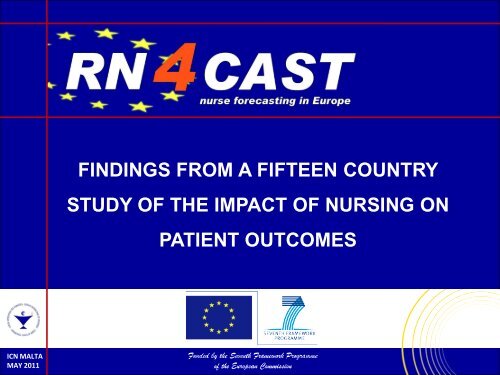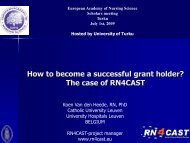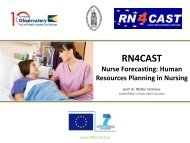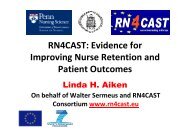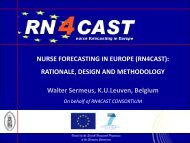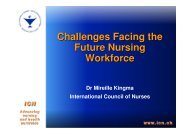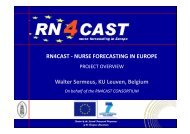to view the RN4CAST symposium presentation
to view the RN4CAST symposium presentation
to view the RN4CAST symposium presentation
You also want an ePaper? Increase the reach of your titles
YUMPU automatically turns print PDFs into web optimized ePapers that Google loves.
ICN MALTA<br />
MAY 2011<br />
FINDINGS FROM A FIFTEEN COUNTRY<br />
STUDY OF THE IMPACT OF NURSING ON<br />
PATIENT OUTCOMES<br />
ICN CONFERENCE AND CNR, 2-8 MAY 2011 MALTA<br />
WWW.<strong>RN4CAST</strong>.EU
ICN MALTA<br />
MAY 2011<br />
<strong>RN4CAST</strong> STUDY PURPOSE AND<br />
OVERVIEW OF DESIGN<br />
Anne Marie Rafferty, King’s College London, UK<br />
ICN CONFERENCE AND CNR, 2-8 MAY 2011 MALTA<br />
WWW.<strong>RN4CAST</strong>.EU
<strong>RN4CAST</strong> RATIONALE<br />
� Worldwide numeric, skill, and geographic imbalances in healthcare<br />
and nursing workforce.<br />
� The workforce crisis is likely <strong>to</strong> increasingly affect quality and safety<br />
of healthcare and health system performance.<br />
� Strategic investments in healthcare and nursing workforce are<br />
expected <strong>to</strong> accelerate health gains by enhancing <strong>the</strong> performance<br />
of health care organizations and health systems.<br />
ICN CONFERENCE AND CNR, 2-8 MAY 2011 MALTA<br />
WWW.<strong>RN4CAST</strong>.EU<br />
3
<strong>RN4CAST</strong> RATIONALE<br />
� Nursing workforce planning and forecasting efforts…<br />
� have a poor record of accurately predicting future nursing<br />
workforce needs and of informing policy interventions that avoid<br />
cyclical shortages.<br />
� don’t take in<strong>to</strong> account <strong>the</strong> dynamics between nurse-<strong>to</strong>-patient<br />
ratios, skill mix, nurse education level, and nursing work<br />
environment on one hand and nurse wellbeing and patient<br />
outcomes on <strong>the</strong> o<strong>the</strong>r hand.<br />
ICN CONFERENCE AND CNR, 2-8 MAY 2011 MALTA<br />
WWW.<strong>RN4CAST</strong>.EU<br />
4
<strong>RN4CAST</strong> OBJECTIVE<br />
The <strong>RN4CAST</strong> project aims innovative forecasting<br />
methods by addressing not only volumes, but<br />
quality of nursing staff as well as quality of patient<br />
care.<br />
ICN CONFERENCE AND CNR, 2-8 MAY 2011 MALTA<br />
WWW.<strong>RN4CAST</strong>.EU<br />
5
<strong>RN4CAST</strong> CONSORTIUM<br />
� <strong>RN4CAST</strong> project co-ordination<br />
� co-ordina<strong>to</strong>r: Walter Sermeus, Katholieke Universiteit Leuven, Belgium<br />
� vice-coordina<strong>to</strong>r: Linda Aiken, University of Pennsylvania<br />
� manager: Koen Van den Heede, Katholieke Universiteit Leuven, Belgium<br />
� <strong>RN4CAST</strong> Partners<br />
� 12 European partners<br />
� U.S.<br />
� 3 International Cooperating Partner Countries of <strong>the</strong> EU<br />
ICN CONFERENCE AND CNR, 2-8 MAY 2011 MALTA<br />
WWW.<strong>RN4CAST</strong>.EU<br />
6
<strong>RN4CAST</strong> CONSORTIUM<br />
ICN CONFERENCE AND CNR, 2-8 MAY 2011 MALTA<br />
WWW.<strong>RN4CAST</strong>.EU<br />
Belgium Catholic University Leuven<br />
England King’s College London<br />
Finland Kuopio University<br />
Germany Technical University Berlin<br />
Greece University of A<strong>the</strong>ns<br />
Ireland Dublin City University<br />
Ne<strong>the</strong>rlands UMC St Radboud Nijmegen<br />
Norway Norwegian Knowledge Centre HSR<br />
Poland Jagiellonian University<br />
Spain Institute of Health Carlos III<br />
Sweden Karolinska Institute<br />
Switzerland Basel University<br />
United States University of Pennsylvania<br />
Botswana University of Botswana<br />
China Sun Yat-sen University<br />
South Africa North-West University<br />
7
<strong>RN4CAST</strong> DESIGN<br />
� Multicountry, multilevel, cross-sectional design <strong>to</strong> obtain important<br />
unmeasured fac<strong>to</strong>rs in forecasting models, collected at <strong>the</strong> hospital, nursing<br />
unit, and individual nurse and patient level:<br />
� Hospital profile data<br />
� Nurse survey<br />
� Patient outcomes data<br />
� Patient survey<br />
� Setting<br />
� At least 30 general acute hospitals in each European country.<br />
� At least 2 general surgical and internal medicine wards in each hospital.<br />
ICN CONFERENCE AND CNR, 2-8 MAY 2011 MALTA<br />
WWW.<strong>RN4CAST</strong>.EU<br />
8
<strong>RN4CAST</strong> DESIGN<br />
Number of hospitals and nursing units<br />
Country Nurse survey Patient survey<br />
N hospitals N units N hospitals N units<br />
Belgium 67 272 60 244<br />
England 46 413 -- --<br />
Finland 32 126 32 128<br />
Germany 49 199 13 /<br />
Greece 24 65 24 65<br />
Ireland 30 112 10 38<br />
Ne<strong>the</strong>rlands 28 131 -- --<br />
Norway 35 238 -- --<br />
Poland 30 119 30 119<br />
Spain 33 281 15 104<br />
Sweden 79 79 -- --<br />
Switzerland 35 134 34 127<br />
Total 486 2169 218 825<br />
ICN CONFERENCE AND CNR, 2-8 MAY 2011 MALTA<br />
WWW.<strong>RN4CAST</strong>.EU<br />
9
<strong>RN4CAST</strong> MALTA SESSION<br />
� Nurses’ reports of working conditions and <strong>the</strong>ir consequences for retention<br />
and quality<br />
Theresa Moreno-Casbas, ISCIII, Spain<br />
� Patients’ perceptions of hospital care and its relation <strong>to</strong> nursing workforce<br />
fac<strong>to</strong>rs<br />
Luk Bruyneel, Katholieke Universiteit Leuven, Belgium<br />
� Impact of nursing on patient mortality<br />
Peter Griffiths, University of Southamp<strong>to</strong>n, England<br />
� Implications for policy<br />
Jesmond Sharples, Direc<strong>to</strong>r of Nursing Services, Malta<br />
� General discussion<br />
Moderated by Anne Marie Rafferty, King’s College London, England<br />
ICN CONFERENCE AND CNR, 2-8 MAY 2011 MALTA<br />
WWW.<strong>RN4CAST</strong>.EU<br />
10
ICN MALTA<br />
MAY 2011<br />
<strong>RN4CAST</strong> Nurses’ reports of working<br />
conditions and <strong>the</strong>ir consequences for<br />
retention and quality<br />
Teresa Moreno-Casbas, Carmen Fuentelsaz-Gallego, Es<strong>the</strong>r González-María &<br />
Mónica Contreras-Moreira<br />
Institu<strong>to</strong> de Salud Carlos III, Ministry of Science and Innovation, Spain<br />
ICN CONFERENCE AND CNR, 2-8 MAY 2011 MALTA<br />
WWW.<strong>RN4CAST</strong>.EU
CONTENTS<br />
� Design of <strong>the</strong> Nurse Survey<br />
� Hospital and Nurse Characteristics<br />
� Nurse-Reported outcomes<br />
� Effects of Nurse Staffing and <strong>the</strong> Nurse Work<br />
Environment<br />
� Implications for Policy and Practice<br />
ICN CONFERENCE AND CNR, 2-8 MAY 2011 MALTA<br />
WWW.<strong>RN4CAST</strong>.EU<br />
12
<strong>RN4CAST</strong> Design of <strong>the</strong> Nurse Survey<br />
� Hospitals<br />
• Acute hospitals<br />
• Above 100 beds size<br />
• At least 30 hospitals/country<br />
� Nursing units<br />
• General medicine and surgery<br />
(cf. Kaneet al., 2007)<br />
• At least 2 units per hospital,<br />
randomly sampled<br />
� Nurses<br />
• All nurses in direct patient care<br />
Nurse survey<br />
� Work environment:<br />
The Practice Environment Scale of <strong>the</strong> Nursing<br />
Work Index (Lake, 2002)<br />
� Nurse wellbeing:<br />
Burnout (Maslach Burnout Inven<strong>to</strong>ry)<br />
Job satisfaction<br />
Intention <strong>to</strong> leave <strong>the</strong> hospital/profession<br />
� Nurse-perceived quality:<br />
Unit and hospital level quality of care<br />
Readiness of patients for discharge<br />
Frequency of adverse events<br />
Safety climate (AHRQ safety culture)<br />
� Staffing: patient-<strong>to</strong>-nurse ratios<br />
� Demographics data<br />
ICN CONFERENCE AND CNR, 2-8 MAY 2011 MALTA<br />
WWW.<strong>RN4CAST</strong>.EU<br />
13
<strong>RN4CAST</strong> Hospital and Nurse Characteristics (mean patient <strong>to</strong> RN ratio)<br />
12<br />
10<br />
8<br />
6<br />
4<br />
2<br />
0<br />
8<br />
6<br />
10 10<br />
6<br />
9<br />
6<br />
BE CH DE ES FI GR IE NL NO PL SE UK <strong>RN4CAST</strong><br />
ICN CONFERENCE AND CNR, 2-8 MAY 2011 MALTA<br />
5<br />
WWW.<strong>RN4CAST</strong>.EU<br />
4<br />
10<br />
6<br />
8 7.2<br />
14
<strong>RN4CAST</strong> Hospital and Nurse Characteristics (percent full time)<br />
100<br />
90<br />
80<br />
70<br />
60<br />
50<br />
40<br />
30<br />
20<br />
10<br />
0<br />
57<br />
47<br />
66<br />
90<br />
94<br />
90<br />
84<br />
BE CH DE ES FI GR IE NL NO PL SE UK <strong>RN4CAST</strong><br />
ICN CONFERENCE AND CNR, 2-8 MAY 2011 MALTA<br />
WWW.<strong>RN4CAST</strong>.EU<br />
44<br />
45<br />
98<br />
60<br />
78<br />
66<br />
15
<strong>RN4CAST</strong> Nurse-Reported Outcomes (I)<br />
80<br />
70<br />
60<br />
50<br />
40<br />
30<br />
20<br />
10<br />
0<br />
BE CH DE ES FI GR IE NL NO PL SE UK <strong>RN4CAST</strong><br />
Poor Environment pct Mixed Environment pct Better Environment pct<br />
ICN CONFERENCE AND CNR, 2-8 MAY 2011 MALTA<br />
WWW.<strong>RN4CAST</strong>.EU<br />
25<br />
16<br />
50<br />
25
<strong>RN4CAST</strong> Nurse-Reported Outcomes (II)<br />
Outcome BE CH DE ES FI GR IE NL NO PL SE UK <strong>RN4CAST</strong><br />
High Emotional<br />
Exhaustion<br />
25 15 30 30 22 78 42 10 24 40 29 42 29<br />
Job Dissatisfaction 22 21 37 38 27 56 42 11 21 26 22 39 26.4<br />
Intent <strong>to</strong> Leave 30 28 36 27 49 49 44 20 26 44 34 44 33.6<br />
Poor Unit Quality 3 1 5 3 0.4 6 1 2 0.5 6 3 2 2.6<br />
Not Confident patients<br />
can manage care<br />
Not Confident<br />
management resolves<br />
problems<br />
% of Nurses reporting…<br />
9 0.6 2 9 0.5 12 3 3 14 22 3 3 6.6<br />
36 22 10 44 24 36 21 34 39 49 22 22 29.5<br />
ICN CONFERENCE AND CNR, 2-8 MAY 2011 MALTA<br />
WWW.<strong>RN4CAST</strong>.EU<br />
17
<strong>RN4CAST</strong> Nurse-Reported Outcomes (III)<br />
% of Nurses reporting occurrence a few times per month or more of…<br />
Outcome BE CH DE ES FI GR IE NL NO PL SE UK <strong>RN4CAST</strong><br />
Medication Errors 21 16 12 12 34 12 8 26 23 4 27 12 20<br />
Ulcers 12 5 7 16 8 25 2 20 13 7 9 9 10<br />
Falls with Injury 9 10 16 5 9 8 13 8 11 2 22 22 14<br />
UTI 22 26 29 24 26 23 17 30 46 4 32 28 28<br />
Central Line Infection 10 16 23 24 12 16 9 8 13 2 13 6 12<br />
Ventila<strong>to</strong>r Related Pneumonia 11 11 17 14 22 20 13 21 3 3 19 15 17<br />
Patient Complaints 32 23 37 43 7 56 26 17 16 42 28 28 28<br />
Verbal Abuse by Patients 32 16 36 37 41 55 49 9 13 41 15 49 26<br />
Verbal Abuse by Staff 10 6 17 9 9 28 13 2 3 15 5 13 8<br />
Physical Abuse by Patients 6 4 8 3 20 11 19 1 2 10 5 19 7<br />
Physical Abuse by Staff 1 0.2 0.3 1 0.5 10 2 0 0.1 3 0.1 1 1<br />
Workplace Injuries 6 3 4 13 8 32 9 2 6 7 9 8 8<br />
ICN CONFERENCE AND CNR, 2-8 MAY 2011 MALTA<br />
WWW.<strong>RN4CAST</strong>.EU<br />
18
<strong>RN4CAST</strong> Nurse-Reported Outcomes (IV)<br />
% of Nurses dissatisfied with …<br />
Outcome BE CH DE ES FI GR IE NL NO PL SE UK <strong>RN4CAST</strong><br />
Work Schedule Flexibility 25 21 17 50 18 45 21 13 25 28 25 25 26<br />
Opportunities for<br />
Advancement<br />
32 30 38 69 51 70 59 34 53 61 62 39 52<br />
at Work 15 6 8 40 9 61 23 10 5 42 8 17 16<br />
Professional Status 25 15 33 50 31 67 28 17 22 45 23 18 27<br />
Wages 63 34 66 63 75 83 74 59 78 79 80 46 69<br />
Educational Opportunities 24 23 30 54 39 77 61 33 51 45 51 33 44<br />
Annual Leave 35 39 24 39 21 54 19 21 30 53 32 13 31<br />
Sick Leave 18 15 23 23 10 52 27 10 9 45 22 19 21<br />
Study Leave 30 35 48 53 19 56 62 29 41 60 31 39 39<br />
Nursing as a Career 12 11 24 11 15 40 28 7 12 14 6 24 13<br />
ICN CONFERENCE AND CNR, 2-8 MAY 2011 MALTA<br />
WWW.<strong>RN4CAST</strong>.EU<br />
19
<strong>RN4CAST</strong> Effects of Nurse Staffing and <strong>the</strong> Nurse Work Environment (I)<br />
• Practice environment and nurse staffing have pronounced<br />
effects on emotional exhaustion, job dissatisfaction, and<br />
intentions <strong>to</strong> leave, and on whe<strong>the</strong>r nurses report that <strong>the</strong><br />
quality of care in <strong>the</strong>ir hospital is poor.<br />
• The nurses work environment has a significant and<br />
pronounced effect on nurses dissatisfaction with all <strong>the</strong> 10<br />
dimensions of work covered by <strong>the</strong> nurse survey.<br />
• Models that estimate <strong>the</strong> effects of <strong>the</strong> environment and<br />
staffing simultaneously, show that <strong>the</strong> effect of <strong>the</strong> work<br />
environment is significant, while <strong>the</strong> effect of staffing is not.<br />
ICN CONFERENCE AND CNR, 2-8 MAY 2011 MALTA<br />
WWW.<strong>RN4CAST</strong>.EU<br />
20
<strong>RN4CAST</strong> Effects of Nurse Staffing and <strong>the</strong> Nurse Work Environment (II)<br />
• Analyzing <strong>the</strong> effects of practice environment and nurse<br />
staffing separately<br />
o Almost all adverse events were significantly affected by <strong>the</strong> nurse<br />
practice environment, except Medication Errors, Falls With Injury,<br />
Ventila<strong>to</strong>r Related Pneumonia and Physical Abuse by Patients<br />
o Almost all adverse events were significantly affected by nursing<br />
staffing/workloads, except Ulcers and Central Line Infection<br />
• Analyzing <strong>the</strong> effects of practice environment and nurse<br />
staffing jointly<br />
o Almost all adverse events were significantly affected by <strong>the</strong> nurse<br />
practice environment, except Falls With Injury, UTI, Ventila<strong>to</strong>r<br />
Related Pneumonia and Verbal Abuse by Patients<br />
o Almost all adverse events were significantly affected by nursing<br />
staffing/workloads, except Ulcers and Central Line Infection<br />
ICN CONFERENCE AND CNR, 2-8 MAY 2011 MALTA<br />
WWW.<strong>RN4CAST</strong>.EU<br />
21
<strong>RN4CAST</strong> Nursing workforce in Spain<br />
Country Shift Mean Min 25th pctl 50th pctl 75th pctl Max<br />
Spain<br />
< 500 beds<br />
(n=18)<br />
Between<br />
500 and<br />
999 beds<br />
(n=10)<br />
< 1000<br />
beds<br />
(n=5)<br />
Morning 10.3 7.2 9.2 10.0 10.9 14.1<br />
Evening 12.1 9.1 11.2 12.3 13.7 15.3<br />
Night 16.1 9.6 14.3 15.5 18.7 27.7<br />
Morning 10.8 7.8 9.5 10.3 12.2 14.1<br />
Evening 12.6 9.7 11.6 13.0 14.2 15.1<br />
Night 17.7 11.2 14.3 16.3 19.7 27.7<br />
Morning 9.8 8.5 9.1 9.6 10.3 11.4<br />
Evening 12.3 10.0 11.2 12.1 13.6 15.3<br />
Night 14.9 11.9 13.9 14.8 16.2 18.7<br />
Morning 9.5 8.1 8.8 9.0 9.5 12.1<br />
Evening 10.9 9.1 9.8 11.4 12.0 12.3<br />
Night 15.2 9.6 13.8 14.3 18.3 19.8<br />
ICN CONFERENCE AND CNR, 2-8 MAY 2011 MALTA<br />
WWW.<strong>RN4CAST</strong>.EU<br />
22
<strong>RN4CAST</strong> Nursing workforce in Spain<br />
70%<br />
60%<br />
50%<br />
40%<br />
30%<br />
20%<br />
10%<br />
0%<br />
Spanish hospitals with 1000 beds<br />
Poor Environment Mixed Environment Better Environment<br />
ICN CONFERENCE AND CNR, 2-8 MAY 2011 MALTA<br />
WWW.<strong>RN4CAST</strong>.EU<br />
23
<strong>RN4CAST</strong> Implications for Policy and Practice<br />
� All countries in our study, representing differently organized<br />
and financed NHS, have hospital quality, safety, and staff<br />
retention problems associated with organizational behaviors<br />
related <strong>to</strong> nursing.<br />
� Nurse staffing/workloads were independently associated with<br />
most outcomes.<br />
� How well nurses in hospitals are faring in terms of burnout<br />
and job dissatisfaction, could be a barometer of how well<br />
patients are faring.<br />
� Nurses’ intentions <strong>to</strong> leave <strong>the</strong>ir jobs in hospitals may portend<br />
trouble for <strong>the</strong> future in Europe.<br />
ICN CONFERENCE AND CNR, 2-8 MAY 2011 MALTA<br />
WWW.<strong>RN4CAST</strong>.EU<br />
24
ICN MALTA<br />
MAY 2011<br />
Patients’ perception of hospital care and its<br />
relation <strong>to</strong> nursing workforce fac<strong>to</strong>rs<br />
Luk Bruyneel, Katholieke Universiteit Leuven, Belgium<br />
ICN CONFERENCE AND CNR, 2-8 MAY 2011 MALTA<br />
WWW.<strong>RN4CAST</strong>.EU
PATIENT SATISFACTION IN THE US<br />
Insights in<strong>to</strong> <strong>the</strong> experiences from patients with<br />
hospital care quality:<br />
� The Hospital Consumer Assessment of Healthcare Providers and<br />
Systems (HCAHPS) survey.<br />
� Publicly reported, consensus-based and nationally standardized<br />
measures of patient satisfaction endorsed in a battery of measures<br />
for quality-moni<strong>to</strong>ring, alongside clinical performance information.<br />
ICN CONFERENCE AND CNR, 2-8 MAY 2011 MALTA<br />
WWW.<strong>RN4CAST</strong>.EU<br />
26
PATIENT SATISFACTION IN THE US<br />
Patients’ perception of hospital care in <strong>the</strong> United States<br />
Ashish K. Jha et al., The New England Journal of Medicine, 2008<br />
“The same characteristics that lead <strong>to</strong> high nurse-staffing levels may be<br />
associated with better experiences for patients.”<br />
� Quality of care was consistently better in hospitals that received high<br />
HCAHPS ratings.<br />
� Specific areas for improvement: nursing care, communication about<br />
medications, pain control and provision of clear discharge<br />
instructions.<br />
ICN CONFERENCE AND CNR, 2-8 MAY 2011 MALTA<br />
WWW.<strong>RN4CAST</strong>.EU<br />
27
PATIENT SATISFACTION IN THE US<br />
Nursing: A Key <strong>to</strong> Patient Satisfaction<br />
Ann Kutney-Lee et al., Health Affairs, 2009<br />
“Investments in nursing are a promising strategy for improving hospital<br />
performance as measured by patient satisfaction.”<br />
� The quality of <strong>the</strong> nursing work environment (measured with Practice<br />
Environment Scale of <strong>the</strong> Nursing Work Index) was significantly<br />
associated with all measures of patient satisfaction.<br />
� Patient <strong>to</strong> nurse ratios significantly affect patient satisfaction.<br />
ICN CONFERENCE AND CNR, 2-8 MAY 2011 MALTA<br />
WWW.<strong>RN4CAST</strong>.EU<br />
28
<strong>RN4CAST</strong>: MEASURING PATIENT SATISFACTION IN EUROPE<br />
First time use of <strong>the</strong> HCAHPS survey in Europe<br />
� Two overall ratings<br />
� Global rating of <strong>the</strong> hospital<br />
� Whe<strong>the</strong>r <strong>the</strong> patient would recommend <strong>the</strong> hospital <strong>to</strong> friends or family<br />
members<br />
� 6 domains<br />
� Communication with physicians<br />
� Communication with nurses<br />
� Communication about medications<br />
� Quality of nursing services<br />
� Adequacy of planning for discharge<br />
� Pain management<br />
� Questions about cleanliness and quietness of room<br />
ICN CONFERENCE AND CNR, 2-8 MAY 2011 MALTA<br />
WWW.<strong>RN4CAST</strong>.EU<br />
29
<strong>RN4CAST</strong>: MEASURING PATIENT SATISFACTION IN EUROPE<br />
� Common research pro<strong>to</strong>col, robust translation<br />
� Collected from patients directly in <strong>the</strong> hospital<br />
� Data available from about 11000 patients (70% response<br />
rate)<br />
� Hospitals (n=218) are <strong>the</strong> units of analysis<br />
ICN CONFERENCE AND CNR, 2-8 MAY 2011 MALTA<br />
WWW.<strong>RN4CAST</strong>.EU<br />
30
GENERAL RATING OF THE HOSPITAL<br />
ICN CONFERENCE AND CNR, 2-8 MAY 2011 MALTA<br />
WWW.<strong>RN4CAST</strong>.EU<br />
31
GENERAL RATING OF THE HOSPITAL<br />
ICN CONFERENCE AND CNR, 2-8 MAY 2011 MALTA<br />
WWW.<strong>RN4CAST</strong>.EU<br />
32
GENERAL RATING OF THE HOSPITAL<br />
ICN CONFERENCE AND CNR, 2-8 MAY 2011 MALTA<br />
WWW.<strong>RN4CAST</strong>.EU<br />
33
NURSE COMMUNICATION<br />
ICN CONFERENCE AND CNR, 2-8 MAY 2011 MALTA<br />
WWW.<strong>RN4CAST</strong>.EU<br />
34
NURSE FACTORS AFFECT PATIENT SATISFACTION<br />
Significant associations between<br />
Patient-<strong>to</strong>-nurse<br />
ratio<br />
Nursing work<br />
environment<br />
Nurse-ratings of<br />
quality of care<br />
Nurse wellbeing<br />
ICN CONFERENCE AND CNR, 2-8 MAY 2011 MALTA<br />
WWW.<strong>RN4CAST</strong>.EU<br />
Patients rating <strong>the</strong><br />
hospital 9 or 10<br />
Patients definitely<br />
recommending <strong>the</strong><br />
hospital<br />
Patients happy with<br />
nurse communication<br />
35
IMPLICATIONS FOR POLICY AND PRACTICE<br />
� Nursing is highly associated with patient satisfaction.<br />
� Reducing nurse burnout and dissatisfaction of nurses and<br />
improving nurse work environments hold promise for<br />
improving patient satisfaction, an important indica<strong>to</strong>r of<br />
quality of care.<br />
� Fur<strong>the</strong>r analysis will focus on<br />
� explaining <strong>the</strong> portion of <strong>the</strong> differences observed within<br />
countries<br />
� linking patient satisfaction data <strong>to</strong> performance on measures of<br />
clinical quality and nurse-rated frequency of adverse events<br />
� …<br />
ICN CONFERENCE AND CNR, 2-8 MAY 2011 MALTA<br />
WWW.<strong>RN4CAST</strong>.EU<br />
36
ICN MALTA<br />
MAY 2011<br />
Impact of nursing on patient<br />
mortality<br />
Peter Griffiths, University of Southamp<strong>to</strong>n, UK<br />
ICN CONFERENCE AND CNR, 2-8 MAY 2011 MALTA<br />
WWW.<strong>RN4CAST</strong>.EU
do <strong>the</strong> sick no harm<br />
“It may seem a strange principle<br />
<strong>to</strong> enunciate as <strong>the</strong> very first<br />
requirement in a hospital that it<br />
should do <strong>the</strong> sick no harm.”<br />
[Florence Nightingale: Notes on Hospitals 1859]<br />
ICN CONFERENCE AND CNR, 2-8 MAY 2011 MALTA<br />
WWW.<strong>RN4CAST</strong>.EU<br />
38
…this is a dangerous place: AHRQ Patient safety Indica<strong>to</strong>rs<br />
Transfusion<br />
Reaction<br />
Sepsis<br />
Respira<strong>to</strong>ry<br />
Failure<br />
Wound<br />
Dehiscence<br />
Pneumothorax<br />
Injuries<br />
HARMS<br />
US Agency for Health Care Research and Quality Patient Safety Indica<strong>to</strong>rs (version 3.1 2007 )<br />
Death<br />
ICN CONFERENCE AND CNR, 2-8 MAY 2011 MALTA<br />
WWW.<strong>RN4CAST</strong>.EU<br />
Decubitus<br />
Ulcer<br />
Failure <strong>to</strong><br />
Rescue<br />
Iatrogenic<br />
Infections<br />
Metabolic<br />
Derangement<br />
Haemorrhage<br />
Hip Fracture<br />
(falls)<br />
39
…administrative data<br />
ICN CONFERENCE AND CNR, 2-8 MAY 2011 MALTA<br />
WWW.<strong>RN4CAST</strong>.EU<br />
40
…<strong>the</strong> <strong>to</strong>wer of Babel: coding used in <strong>RN4CAST</strong> countries<br />
ICN CONFERENCE AND CNR, 2-8 MAY 2011 MALTA<br />
WWW.<strong>RN4CAST</strong>.EU<br />
Diagnosis<br />
Procedure<br />
Belgium ICD-9-CM ICD-9-CM<br />
Finland ICD-10 Local based on NCSP<br />
Germany ICD-10-GM OPS 2010<br />
Ireland ICD-10 ICD10 AM<br />
Norway ICD-10 NCSP<br />
Poland ICD-10 ICD-9<br />
Spain ICD-9-CM ICD-9-CM<br />
Sweden ICD-10 Local based on NCSP<br />
Switzerland ICD-10 CHOP -> based on ICD 9<br />
procedures<br />
Ne<strong>the</strong>rlands ICD-9-CM ICD 9<br />
UK ICD-10 OPCS<br />
41
…<strong>the</strong> human fac<strong>to</strong>r<br />
2<br />
1.5<br />
1<br />
UK Nursing outcome study: effect of nurse patient ratio - odds<br />
ratios for patient and nurse outcomes<br />
12 patients<br />
per nurse<br />
Fair/poor quality care<br />
High emotional exhaustion<br />
Job dissatisfaction<br />
Mortality<br />
ICN CONFERENCE AND CNR, 2-8 MAY 2011 MALTA<br />
WWW.<strong>RN4CAST</strong>.EU<br />
Source data: Rafferty, A. M., S. P. Clarke, et al.<br />
(2007). "Outcomes of variation in hospital<br />
nurse staffing in English hospitals: Crosssectional<br />
analysis of survey data and<br />
discharge records." Int J Nurs Stud. 44, 2<br />
�<br />
42
….what can you buy for €2307?<br />
A cheap used car<br />
An expensive TV<br />
One or two nights in a very expensive<br />
hotel<br />
ICN CONFERENCE AND CNR, 2-8 MAY 2011 MALTA<br />
WWW.<strong>RN4CAST</strong>.EU<br />
43
ICN MALTA<br />
MAY 2011<br />
IMPLICATIONS FOR POLICY<br />
Jesmond Sharples, Direc<strong>to</strong>r of Nursing Services, Malta<br />
ICN CONFERENCE AND CNR, 2-8 MAY 2011 MALTA<br />
WWW.<strong>RN4CAST</strong>.EU
Summary .... Increased nurse <strong>to</strong> patient ratios<br />
• Patient Satisfaction<br />
• Improved Patient Outcomes<br />
• Improvement in Communication<br />
• Quality of Nurse Work Environment<br />
• Nurse well-being<br />
ICN CONFERENCE AND CNR, 2-8 MAY 2011 MALTA<br />
WWW.<strong>RN4CAST</strong>.EU<br />
45
Nurse<br />
Wellbeing<br />
Patient<br />
Outcomes<br />
Nursing Work<br />
Environment<br />
Nurse-<strong>to</strong>patient<br />
ratios<br />
ICN CONFERENCE AND CNR, 2-8 MAY 2011 MALTA<br />
WWW.<strong>RN4CAST</strong>.EU<br />
KEY POLICY AREAS<br />
Skill mix<br />
Levels of<br />
education<br />
46
PATIENT SATISFACTION<br />
Policy direction regarding <strong>the</strong> measurement of Patient<br />
Satisfaction as a Quality Indica<strong>to</strong>r - communication, respect,<br />
coordination of care, nursing care, discharge process, advocacy and patient<br />
compassionate care.<br />
Patient Satisfaction is not an absolute measure but only an<br />
indica<strong>to</strong>r of patient expectations that need <strong>to</strong> be heeded<br />
<strong>to</strong>.<br />
Quality and Fairness - A Health System for You that “a<br />
national standardised approach <strong>to</strong> <strong>the</strong> measurement of<br />
patient’s satisfaction will be introduced”<br />
ICN CONFERENCE AND CNR, 2-8 MAY 2011 MALTA<br />
WWW.<strong>RN4CAST</strong>.EU<br />
47
IMPROVED PATIENT OUTCOMES<br />
The percentage of RN hours of care is positively correlated <strong>to</strong> patients'<br />
perception of health status and a number post-discharge patient<br />
satisfaction measures and a number of patient outcomes such as<br />
health status, falls index, medication errors index, ability <strong>to</strong> self-care<br />
etc<br />
As a hospital responds <strong>to</strong> economic constraints and market variability,<br />
it is imperative that a critical number of RN staff be maintained.<br />
There isn’t ideal percentage of RN hours of care. Look out for <strong>the</strong><br />
potential effects major reductions might have on patient outcomes<br />
and where analysis should be directed in those situations.<br />
ICN CONFERENCE AND CNR, 2-8 MAY 2011 MALTA<br />
WWW.<strong>RN4CAST</strong>.EU<br />
48
IMPROVEMENT IN COMMUNICATION<br />
• Key Policy decisions should address <strong>the</strong> need <strong>to</strong><br />
develop nurse leadership through staff<br />
development initiatives<br />
• This will improve leaders’ ability <strong>to</strong> connect with<br />
subordinates resulting in an improved<br />
organisational behaviour through improved<br />
management practices<br />
• Organisational systems and structures should be<br />
re<strong>view</strong>ed <strong>to</strong> improve organisational well-being<br />
ICN CONFERENCE AND CNR, 2-8 MAY 2011 MALTA<br />
WWW.<strong>RN4CAST</strong>.EU<br />
49
QUALITY OF WORK ENVIRONMENT<br />
• Staffing and resource adequacy<br />
• Physical Environment<br />
• Social Environment<br />
• Emotionally intelligent policies and practices<br />
ICN CONFERENCE AND CNR, 2-8 MAY 2011 MALTA<br />
WWW.<strong>RN4CAST</strong>.EU<br />
50
NURSE WELL-BEING<br />
• Key Policy decisions that affect nurse well-being<br />
should include all <strong>the</strong> biopsychosocial dimensions<br />
• Development of leadership competencies<br />
• Provision of family friendly measures,<br />
Psychological counselling and o<strong>the</strong>r support in a<br />
formal and structured manner.<br />
ICN CONFERENCE AND CNR, 2-8 MAY 2011 MALTA<br />
WWW.<strong>RN4CAST</strong>.EU<br />
51
CONCLUSION<br />
"Unless we are making progress in our nursing<br />
every year, every month, every week, take my<br />
word for it we are going back."<br />
Florence Nightingale, 1914<br />
"It is not how much you do, but how much love you<br />
put in <strong>the</strong> doing.“<br />
Mo<strong>the</strong>r Theresa<br />
ICN CONFERENCE AND CNR, 2-8 MAY 2011 MALTA<br />
WWW.<strong>RN4CAST</strong>.EU<br />
52


